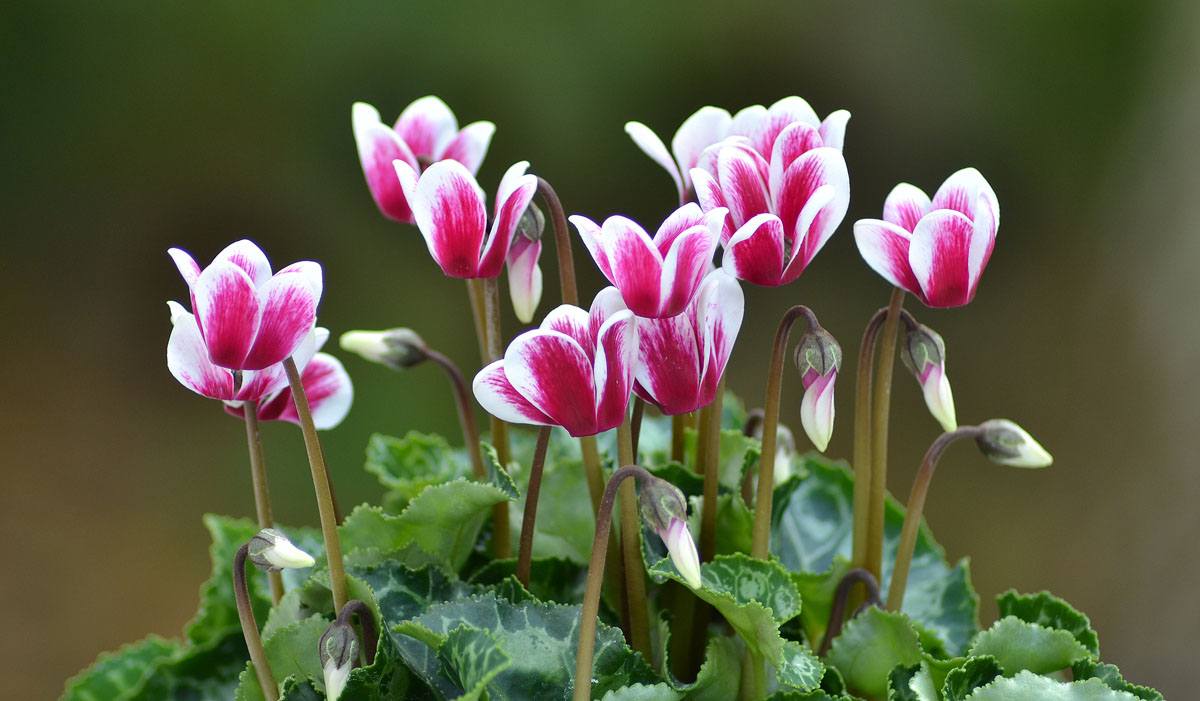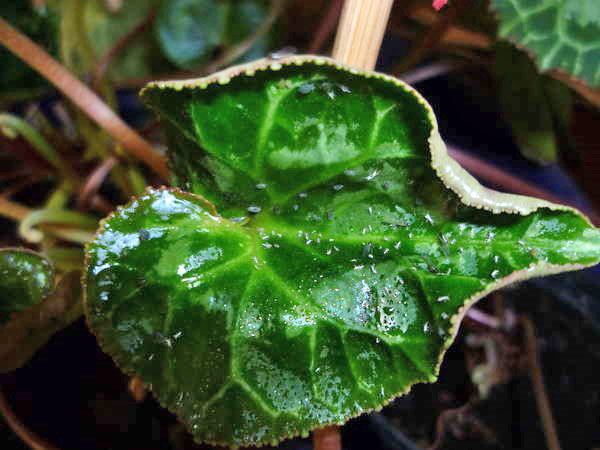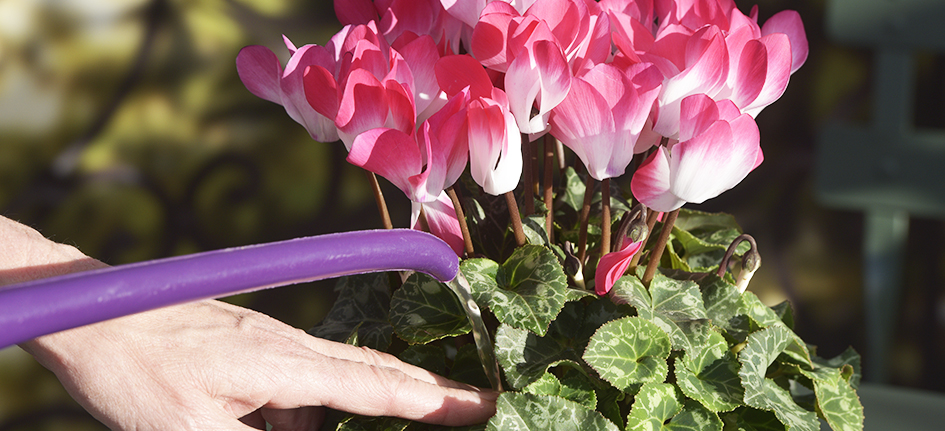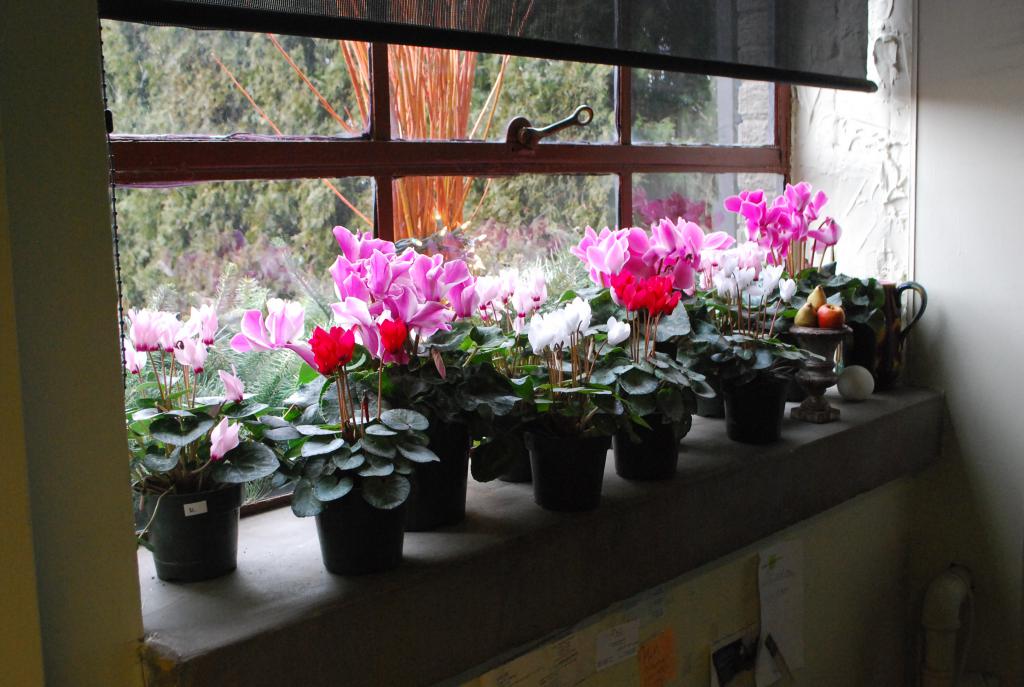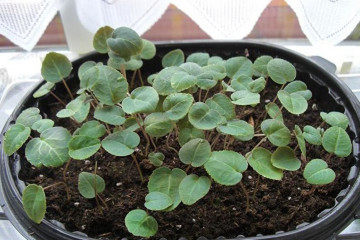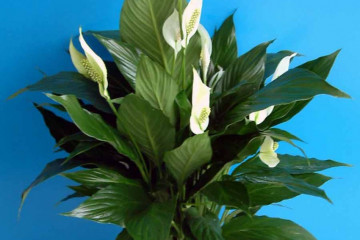Why cyclamen does not bloom: the main reasons and methods of resuscitation
Content:
Cyclamen is a herb that is grown outdoors and at home. Representative of the Primroses family. If the cyclamen is properly looked after, it will delight you with fragrant exotic flowers during the flowering season.
Why does not the plant bloom
Owners of flowering plants expect a lush bloom throughout the season, for various reasons the buds may not bloom.
Not everyone knows how to help the plant, what to do if the leaves turn yellow on the cyclamen, or pests have spoiled it.
Elevated temperature
One of the reasons why cyclamen does not bloom is the increased air temperature in the room. Primroses bloom in the cold season, they do not tolerate heat well. Temperatures above 18 ° C are considered high for a flower. It is necessary to pay attention to the place in which the pot stands. During the heating season, primroses should not stand on window sills, under which there are radiators.
Root system at great depth
Deeply buried roots are the main reason why cyclamen does not bloom, but only leaves grow. In this case, the stem of the flower is partially submerged in the ground, which interferes with flowering. The plant pot may have been incorrectly chosen and too deep.
Diseases and pests
One of the reasons why cyclamen leaves curl is due to pests. The plant will not be able to bloom until the problem is fixed.
Diseases of cyclamen
Diseases in cyclamen can be caused by viruses, fungi and microbes. Diseases can develop if the flower grows under inappropriate conditions. If you do not take action in time, the plant will begin to die.
Yellowed leaves
Cyclamen can shed leaves with a dormant period when the plant stops growing. In this case, they fall off slowly, this is a normal process. If the foliage has fallen quickly and almost completely, this is a serious problem.
Cyclamen leaves can turn yellow and fall off if not properly cared for.
What you need to pay attention to:
- Air temperature. The plant may be too hot;
- Humidity. Cyclamen grows well at medium and high humidity;
- The amount of water for irrigation. Moisture should not stagnate;
- Ventilation. In poorly ventilated rooms or in strong drafts, the flower feels uncomfortable;
- The place where the flower pot stands. Direct sunlight should not fall on it, from which the leaves burn out. In this case, the yellowing may turn out to be a sunburn.
If the leaves of cyclamen turn yellow and wither, the care at home has not changed, the problem may be in the soil. It can be infected with fungi and viruses that infect the flower. A fungal disease in which the foliage turns yellow and falls off is called fusarium.The fungus is dangerous because it clogs the vessels of the plant and releases toxins.
Wet rot
Through cracks in the tubers, the plant can pick up a bacterial infection, resulting in wet rot. It is simple to recognize the disease: the plant sharply weakens and withers, a rotten smell appears. It is useless to treat the flower, it is better to throw it away immediately so that the rot does not spread to healthy plants.
Gray mold
Gray mold is a fungal disease that manifests itself in the form of a plaque with a silvery sheen on the foliage. Mildewed flowering stems darken and fall off.
The main reason for the appearance is a combination of dampness and cold air in the room. If water gets into the middle of the bud and onto the leaves during watering, they can become moldy over time. If you find a problem, you must immediately remove the affected areas using a sharpened knife. The rest of the flower requires fungicide treatment.
Root rot
Cyclamen roots rot from the influence of fungi that start in the ground. Often, the disease appears if the flower is planted in ordinary garden or contaminated soil.
The problem is not always immediately recognizable, since only the roots are exposed to rot. You need to pay attention to the leaves, in this case they do not have enough nutrition, and they turn pale green.
An adult cyclamen can be reanimated; it must be pulled out of the pot and rinsed from the ground. All damaged areas of the roots are cut off, healthy ones must be treated with a fungicide. The plant is planted in a cleaned soil mixture, which is pre-treated with hot steam.
Other
In addition to the main problems, the following diseases are found in cyclamen:
- Anthracnose is a fungal disease that primarily affects the peduncle. The top of the flowering stem dries up, it itself has a distorted shape;
- Late blight rot is a fungal disease that is difficult to recognize. In the early stages, a spoiled flower does not differ from a healthy one; over time, its growth is disrupted. It begins to dry out and wither, the leaves change color;
- A sooty fungus is a dark bloom that covers the surface of the foliage. Due to plaque, the plant does not receive enough sunlight and begins to wilt.
Potential pests
A common problem is that cyclamen leaves curl, why is this happening?
The main reason is the defeat of the flower by pests, among which are most often found:
- Aphids are tiny insects that suck sap out of the plant. The leaves quickly curl and become sticky, if flowering occurs, the buds have a curved shape;
- Mite. It is no larger than a grain of sand and cannot be recognized. The adult tick and its larvae suck the juices and vitality from the cyclamen;
- The scale insect is a dark insect that sits motionless on the leaves of the cyclamen and sucks the juice out of it;
- Thrips are flying insects that grow in hot, dry weather. The affected flower slows down its growth, its leaves and stems are bent.
Flower resuscitation options
It is possible to revive and preserve the flower only in the early stages of the lesion, when there are no serious deformations of the stem and foliage.
What you need to do to save the cyclamen:
- Determine the disease and its cause. For example, the problem is stagnant moisture, poor-quality soil or high temperature;
- Remove the damaged parts of the flower: leaves, stems, damaged roots;
- The surviving parts are treated with a solution, the choice of which depends on the disease of the plant;
- If the problem is in the soil, transplantation into a new high-quality substrate will be required;
- The plant continues to be looked after, watering, temperature and lighting are controlled.
If the leaves of the cyclamen are curled from pests, the problem must be eliminated.
You can fight pests with folk remedies or insecticides, which is better to use:
- Chemicals will help get rid of aphids: Aktara, Fitoverm, Agrovertin. The leaves are treated with a cotton swab dipped in a solution, after which the plant is washed under the shower;
- When choosing chemicals, it must be borne in mind that ticks are not insects, and conventional remedies will not help. Acaricides Neoron and Sunmight will help to fight the pest;
- Solutions of Aktar, Fitoverm and Bankol, with which the leaves need to be processed, will help get rid of the scabbard. In adults, it is possible to fly to different bushes, therefore, processing is carried out every 14-30 days;
- In the fight against thrips, it is better to prevent their appearance. It is necessary to maintain normal humidity and air temperature, especially in summer. If insects are bred, the chemicals Akarin, Fitoverm and Agrovertin will help get rid of them.
Young flowers do not rest in summer and bloom profusely; for adult plants, rest in the hot season is of great importance. If you do not give the cyclamen a rest, natural rhythms go astray. To make the cyclamen bloom in the next season, it is necessary to get rid of problems and take proper care of it.
Further home care
If the cyclamen has faded, what to do next at home and how to care for it? Caring for a cyclamen after flowering means proper watering and maintaining the right temperature.
Attention should be paid to care during the rest period, when the daytime temperature reaches 20 ° C. This period lasts from mid-April to September, at this time the cyclamen does not bloom, its leaves dry and fall off.
Proper watering
It is enough to water the flower once a week; before the next watering, the top layer of the earth must completely dry out. After watering, the soil should be moist, but not soggy. You can only use purified or settled water.
If the cyclamen has faded, what to do next and how to water it:
- During the rest period, watering is not stopped, it is reduced to 2-3 times a month;
- Water the plant with a little water, depending on the size of the pot;
- After 2 months of rest, the amount of water is gradually increased in order to return to normal by the time of flowering.
Note! For cyclamen, sufficient air humidity is needed, in addition to watering, the plant should be periodically sprayed with water.
Top dressing and fertilizers
For active growth and lush flowering, the plant needs to be fertilized.
Features of feeding cyclamen:
- For an adult flower, top dressing is carried out 1-2 times a month before the formation of buds. As a fertilizer, you can choose the liquid fertilizer "Floretta";
- At home, you can make your own fertilizer by mixing 2 liters of water and 6 tbsp. l. wood ash;
- If the plant is young and still growing, you can feed it with calcium nitrate;
- It is better to minimize the use of mineral compositions; cyclamen does not tolerate high salt concentrations;
- The use of chlorine fertilizers is not allowed;
- Fertilizer should be applied only to moist soil;
- It is undesirable to use complex fertilizers for deciduous plants, otherwise, instead of buds, foliage will begin to actively grow;
- After flowering, all feeding must be stopped.
Lighting
Cyclamen is a light-loving plant, it needs bright diffused lighting. It is advisable to avoid direct sunlight, from which the leaves will dry and crumble. The plant can stand near a window on the east, west and southwest sides.In the morning and in the evening, it is allowed to place a flower on the windowsill near the south window.
Temperature
One of the common questions of indoor flower owners is “If the cyclamen remains in the pot after flowering, what to do with it and at what temperature should it be stored?”. The plant feels well at daytime temperatures from 10 to 18 ° C and at night temperatures within 6-9 ° C. During the heating season, the cyclamen should be kept away from radiators and heaters.
During the dormant period, the flower should be indoors at a temperature of 15-20 ° C, it can be stored in basements, cellars or in an air-conditioned room. If in hot summer it is not possible to provide the required temperature, storage in the refrigerator is allowed. The plant is dug out of the ground, the roots are wrapped in polyethylene and placed in the lower compartment for storing vegetables.
Primroses require special conditions of detention, in unfavorable ones - they will not bloom. If the leaves of the cyclamen quickly turn yellow, or the plant looks sickly, you must immediately help it. Wrong or untimely actions can ruin the flower.
